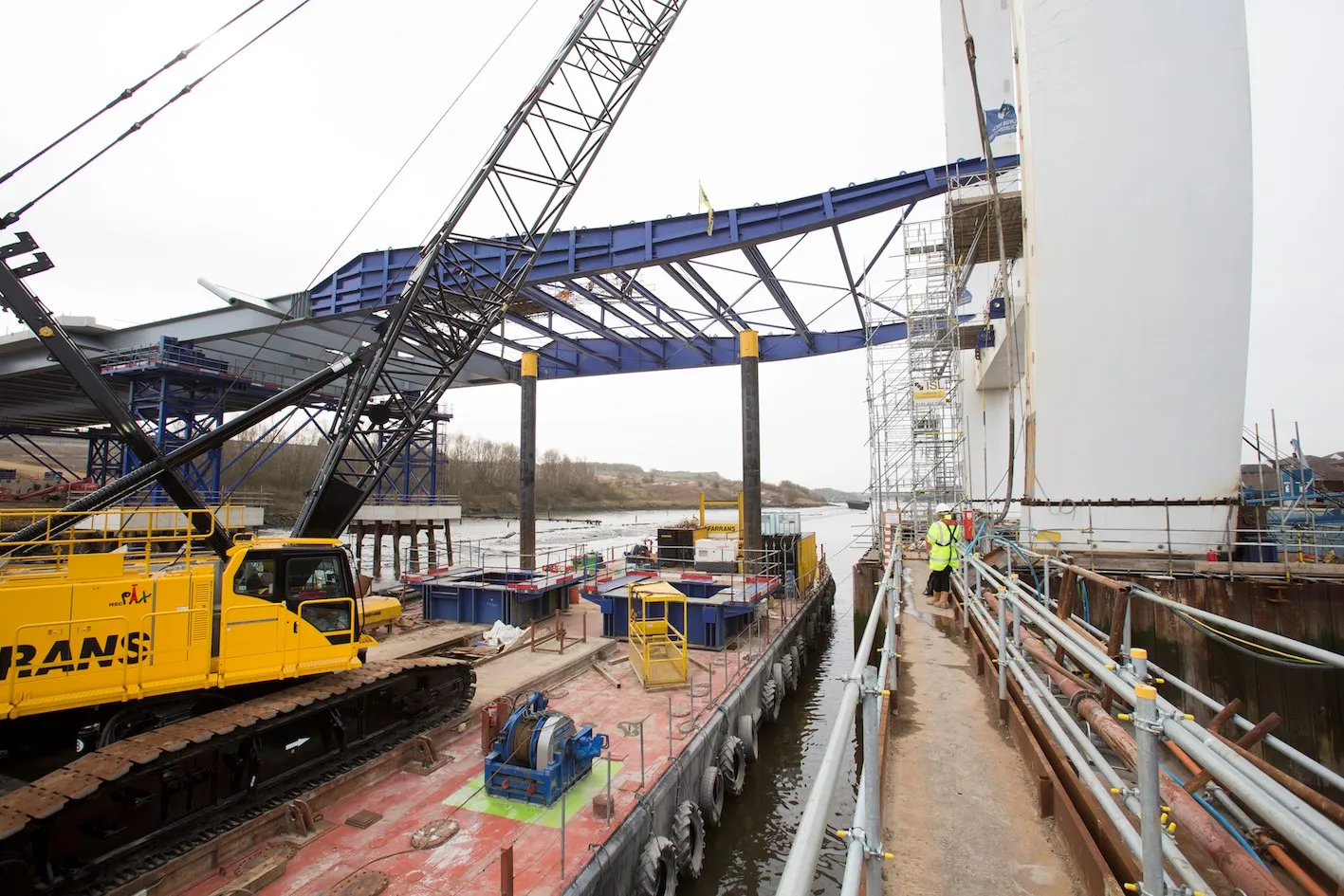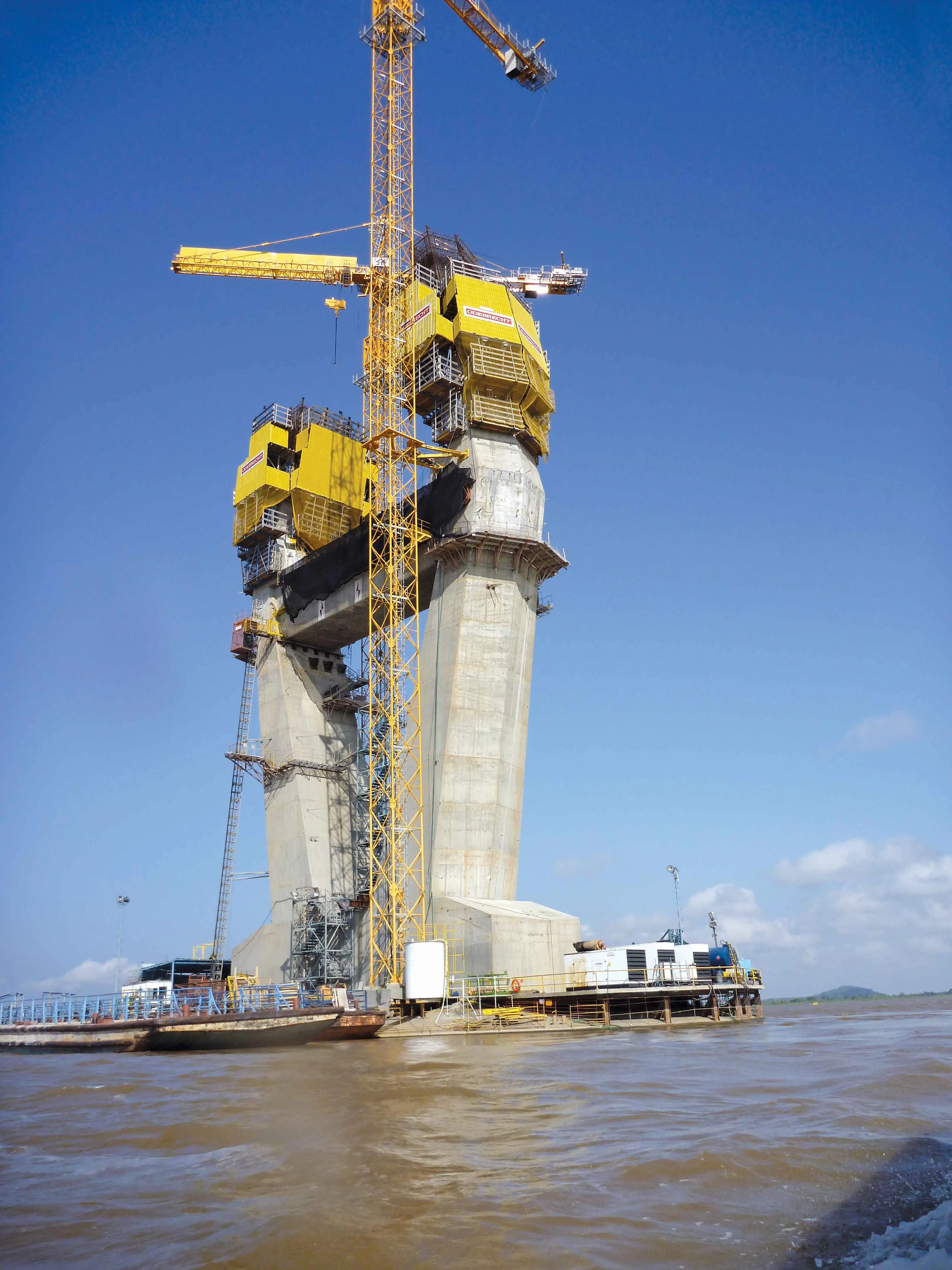The team constructing the New Wear Crossing near the English city of Sunderland is preparing for the final launch of the 300m bridge deck.
In recent weeks, the legs of the 100m-tall centrepiece have been secured to the foundations within the riverbed and most of the rigging used to raise it into place has been removed.
While the bridge deck was being painted, the bottoms of both pylon legs were filled with 175tonnes of concrete,
The next major process will be to slowly pull the bridge deck out acr
March 24, 2017
Read time: 4 mins

The team constructing the New Wear Crossing near the English city of Sunderland is preparing for the final launch of the 300m bridge deck.
In recent weeks, the legs of the 100m-tall centrepiece have been secured to the foundations within the riverbed and most of the rigging used to raise it into place has been removed.
While the bridge deck was being painted, the bottoms of both pylon legs were filled with 175tonnes of concrete,
The next major process will be to slowly pull the bridge deck out across the river by hydraulic jacks in an operation that is likely to take two days. It will pass between the two pylon arches on its way to the opposite river bank to eventually rest on abutments.
Work is being carried out by a joint venture of1622 Farrans Construction and Victor Buyck Steel Construction to deliver the project for Sunderland City Council. Sub-contractors and suppliers include Northumbrian Roads, 2399 Tarmac, TM Lincs and Nicholson Energy. The FVB’s design team is led by Buro Happold Engineering and Roughan & O'Donovan along with independent checker 6801 Ramboll.
Stephen McCaffrey, project director for FVB Joint Venture, said the project was on schedule for completion next spring. “At 300m long and weighing 4,750tonnes, launching the deck across the river will be a very slow and steady process. People probably won’t be able to actually see the bridge deck physically move, but over the course of time its progress will be visible.”
Once in place, the deck will span from where it has been assembled on the south side of the river in Pallion to the north side in Castletown, both close to Sunderland. But a 40m section of decking will have to be constructed over the summer on the north side in order to complete the full length of the bridge.
The bridge is part of a scheme to improve links from the A19 to Sunderland city centre and the Port of Sunderland. Importantly, it will enable a huge area of land along the south side of the riverbank to be regenerated and developed, according to the city.
Since construction started in May 2015, much of the work has centred on building the cofferdam and pylon foundations within the riverbed, constructing the approach roads on the south side and assembling the bridge deck. Roadworks have also been carried out on both sides of the river to prepare the current road network for the opening of the bridge in the spring of 2018.
He said: “The pylon is now secured and free-standing, but there is still a bit of work to do to remove all of the rigging used in raising the pylon, as well as some of the scaffolding. We have been hampered slightly by strong winds during the last week or so, but provided the weather calms down, we should be able to have everything ready for the bridge deck launch fairly soon.
It will be great to see the deck take its final position.”
Stephen thanked motorists and residents for their patience during the programme of roadworks on both sides of the river, at Pallion Junction and in and around Wessington Way in Castletown, and said work would be largely complete in both areas around the end of May, although minor works will continue.
He said: “We appreciate that roadworks can be frustrating and can slow you down, but they are necessary for us to complete this project. We ask people to bear with us and to drive carefully and according to the speed limits and traffic measures in place. They are there to protect our workforce and road-users.”
In recent weeks, the legs of the 100m-tall centrepiece have been secured to the foundations within the riverbed and most of the rigging used to raise it into place has been removed.
While the bridge deck was being painted, the bottoms of both pylon legs were filled with 175tonnes of concrete,
The next major process will be to slowly pull the bridge deck out across the river by hydraulic jacks in an operation that is likely to take two days. It will pass between the two pylon arches on its way to the opposite river bank to eventually rest on abutments.
Work is being carried out by a joint venture of
Stephen McCaffrey, project director for FVB Joint Venture, said the project was on schedule for completion next spring. “At 300m long and weighing 4,750tonnes, launching the deck across the river will be a very slow and steady process. People probably won’t be able to actually see the bridge deck physically move, but over the course of time its progress will be visible.”
Once in place, the deck will span from where it has been assembled on the south side of the river in Pallion to the north side in Castletown, both close to Sunderland. But a 40m section of decking will have to be constructed over the summer on the north side in order to complete the full length of the bridge.
The bridge is part of a scheme to improve links from the A19 to Sunderland city centre and the Port of Sunderland. Importantly, it will enable a huge area of land along the south side of the riverbank to be regenerated and developed, according to the city.
Since construction started in May 2015, much of the work has centred on building the cofferdam and pylon foundations within the riverbed, constructing the approach roads on the south side and assembling the bridge deck. Roadworks have also been carried out on both sides of the river to prepare the current road network for the opening of the bridge in the spring of 2018.
He said: “The pylon is now secured and free-standing, but there is still a bit of work to do to remove all of the rigging used in raising the pylon, as well as some of the scaffolding. We have been hampered slightly by strong winds during the last week or so, but provided the weather calms down, we should be able to have everything ready for the bridge deck launch fairly soon.
It will be great to see the deck take its final position.”
Stephen thanked motorists and residents for their patience during the programme of roadworks on both sides of the river, at Pallion Junction and in and around Wessington Way in Castletown, and said work would be largely complete in both areas around the end of May, although minor works will continue.
He said: “We appreciate that roadworks can be frustrating and can slow you down, but they are necessary for us to complete this project. We ask people to bear with us and to drive carefully and according to the speed limits and traffic measures in place. They are there to protect our workforce and road-users.”








